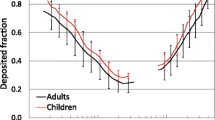Summary
Symptoms and pulmonary function were evaluated in subjects exposed to trichlorophenol. Symptoms from upper airways and chest were more common among those exposed than in control subjects (60% and 10%, respectively). Significantly reduced forced expired flow at 75% of vital capacity [exposed: 5.721A (5.08–6.85), mean and range; reference: 6.451A (5.77–8.40), P < 0.05] and increased closing volume [exposed: 25.2% (19.5–36.0), reference: 17.l% (12.0–23.5), P < 0.01] were measured while other spirometric variables and the transfer factor of the lung for CO were normal. Increased elastic recoil pressure of the lung and signs of lung tissue engagement in X ray were noticed in two subjects. Blood and liver tests were normal. The findings suggest an irritating effect on the lung by trichlorophenol, and it cannot be excluded that long-term exposure may produce pulmonary fibrosis.
Similar content being viewed by others
References
Alexandersson R (1979) Exposure to cobalt. II. Pulmonary reactions in the tungsten carbide industry. Arbete Och Hälsa 10:1–34
Berglund E, Birath G, Bjure J, Grimby G, Kjellmer I, Sandqvist L, Sbderholm B (1963) Spirometric studies in normal subjects. Acta Med Scand 173:195–199
Buist AS, Ross BB (1973) Predicted values for closing volumes using a modified single breath nitrogen test. Am Rev Respir Dis 107:744–752
Cherniack RM, Raber MB (1972) Normal standards for ventilatory function using an automated wedge spirometer. Am Rev Respir Dis 106:38–46
Cotes JE (1968) Lung function. Assessment and application in medicine. Blackwell, Oxford, pp 249–255, 384–385
Diem K (1962) Documenta Geigy Scientific Tables. Geigy, Basle
Fries N, West U (1921) Chemical warfare. McGraw Hill, New York, p 445
Gildemeister F, Heubner N (1920) Ober Kampfgas-Vergiftungen. VI. Die Chlorpikrin-Vergiftung. Z Exper Med 13:291
Hedenstierna G, Alexandersson R, Kolmodin-Hedman B, Szamosi A, Tollqvist J (1981) Pleural plaques and lung function in construction workers exposed to asbestos. Eur J Respir Dis 62: 111–122
Jodoin G, Gibbs GW, Macklem PT, McDonald JC, Becklake MR (1971) Early effects of asbestos exposure on lung function. Am Rev Respir Dis 104:525–535
Jonson B (1970) Pulmonary mechanics in normal men, studied with the flow regulator method. Scand J Clin Lab Invest 25:363–379
Kolmodin-Hedman B, Alexandersson R, Hedenstierna G (1980) Diisocyanates - MDI. Lung physiology studies on personnel from plastic industry. Arbete Och Hdlsa 10:1–18
McCarthy DS, Spencer R, Greene R, Milic-Emili J (1972) Measurement of ‘closing volume’ as a simple and sensitive test for detection of small airway disease. Am J Med 52:747–753
Macklem PT (1972) Obstruction in small airways – a challenge to medicine. Am J Med 52:721–724
Oxhøj H, Bake B, Wilhelmsen L (1977) Ability of spirometry, flow-volume curves and the nitrogen closing volume test to detect smokers. Scand J Respir Dis 58:80–96
Author information
Authors and Affiliations
Additional information
Supported by grants from Petrus and Augusta Hedlunds Foundation and the Labour Safety Foundations
Rights and permissions
About this article
Cite this article
Alexandersson, R., Hedenstierna, G. Pulmonary function after long-term exposure to trichlorophenol. Int. Arch Occup Environ Heath 49, 275–280 (1982). https://doi.org/10.1007/BF00377936
Received:
Accepted:
Issue Date:
DOI: https://doi.org/10.1007/BF00377936




